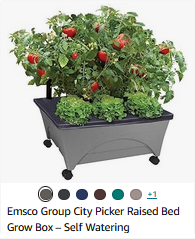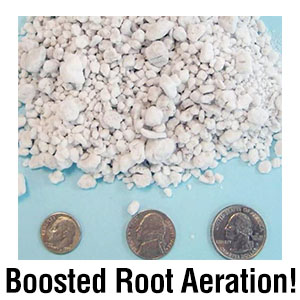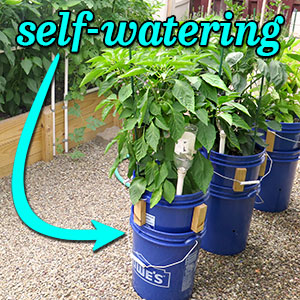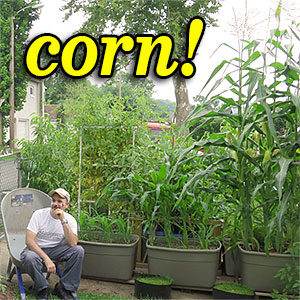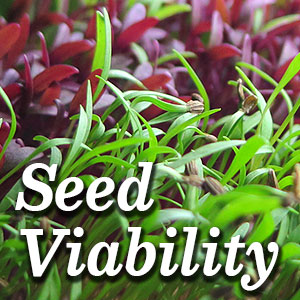The Best DLI Calculator
(DLI: What is Daily Light Integral?)
There's a direct relationship between light intensity and photoperiod. DLI is the measurement that accounts for both parameters. Light intensity (as measured in PPFD) is documented and then converted to a 24 hour period, adjusting for the dark cycle as well.
Once you understand how DLI is calculated, you'll see how plant scientists are able to track exactly how much light plants are getting on a daily basis. This is an extremely useful metric because it helps a grower to determine when artificial lighting is needed. How bright do the lights need to be? At what times should they be operated? The daily light integral will help to answer those questions.
- Daily Light Integral for Plants:
- What is DLI (Daily Light Integral)?
- DLI / PPFD Conversion Calculator
- Daily Light Integral Formula
- DLI Terminology
- Daily Light Integral Maps
- Daily Light Integral Chart
- Daily Light Integral for Plants
What is DLI (Daily Light Integral)?
DLI stands for the Daily Light Integral. This is a measurement designed to represent the total amount of Photosynthetically Active Radiation (PAR) received by a plant over the course of a 24 hour day. Using a quantum light meter, it's possible to quantify the number of PAR photons falling on a surface in any given second of time. This measurement is denoted as the PPFD. The PPFD is a useful measurement, but it doesn't tell you how much light a plant is getting on a daily basis. As you would expect, your plants can get a larger daily dose of PAR photons if you increase the duration of your light cycle.
The system becomes even more complex when including natural sunlight. Not only does the duration of sunlight change depending on latitude and time of year, but the solar radiation levels will change depending on the time of day. With this high level of variability, it becomes difficult to gauge how much light your plants are getting on a daily basis. This is why DLI is so important. Rather than measuring the total photons received within a second, you're able to quantify the PAR photon dosage over the course of 24 hours.
DLI / PPFD Conversion Calculator:
This two part DLI calculator is very easy to use. To figure out your plant's DLI, simply input your PPFD spot reading and the hours per day of your light cycle. Then click the button.
The second calculator will show you the PPFD level required to achieve your desired DLI. Input the target DLI and the light cycle you intend to use. Once you push the button, you will see required PPFD.
Daily Light Integral Formula:
The DLI calculator shown above works very well. What math is it based on though? The formula for calculating DLI is fairly simple. In situations where plants are receiving 100% artificial light, it's easy to figure out the DLI.
DLI FORMULA: DLI = PPFD × Daily Light Hours × (3600 / 1,000,000)
To determine the Daily Light Integral your plants are exposed to, you need to know the PPFD (photosynthetic photon flux density) at the plant canopy. Next you need to account for the daily light hours, based on the light cycle duration.
Video: Photoperiod vs Intensity:
What is DLI?
This lettuce experiment demonstrates the relationship between Photoperiod, PPFD & the resulting DLI.
DLI Terminology:
PHOTOPERIODISM: The physiological growth or reproduction response of a plant when exposed to a specific photoperiod or day length and the corresponding period of darkness.
DLI: Daily Light Integral refers to the total number of PAR photons, delivered to a square meter area through the course of a 24-hour period. It is expressed as moles of light (mol) per square meter (m−2) per day (d−1).
PPFD: Photosynthetic Photon Flux Density as measured in micromoles per second, per square meter(μmol/m2/s) is a snapshot of all PAR light falling on a surface within a single second.
Daily Light Integral Maps:

These maps show the average DLI across the United States for each month of the year. (click to enlarge)

U.S. DLI MAPS: Researchers from Purdue University have analyzed the solar radiation levels over a 14 year period. This data then allowed them to compile DLI maps all across the United States. Daily light integral varies significantly depending on latitude and other geographic factors. But the light levels also change dramatically depending on the time of year.
To properly depict the fluctuation in DLI across both space and time, 12 monthly DLI maps for the lower 48 states can been seen above. As plants assimilate solar radiation, this directly drives plant growth. Different plant types have different DLI requirements for optimal health. This is why horticulturists and commercial growers pay very close attention to this metric.
You can check here to seen an interactive version of these maps: U.S. Daily Light Integral Map
Daily Light Integral Chart:
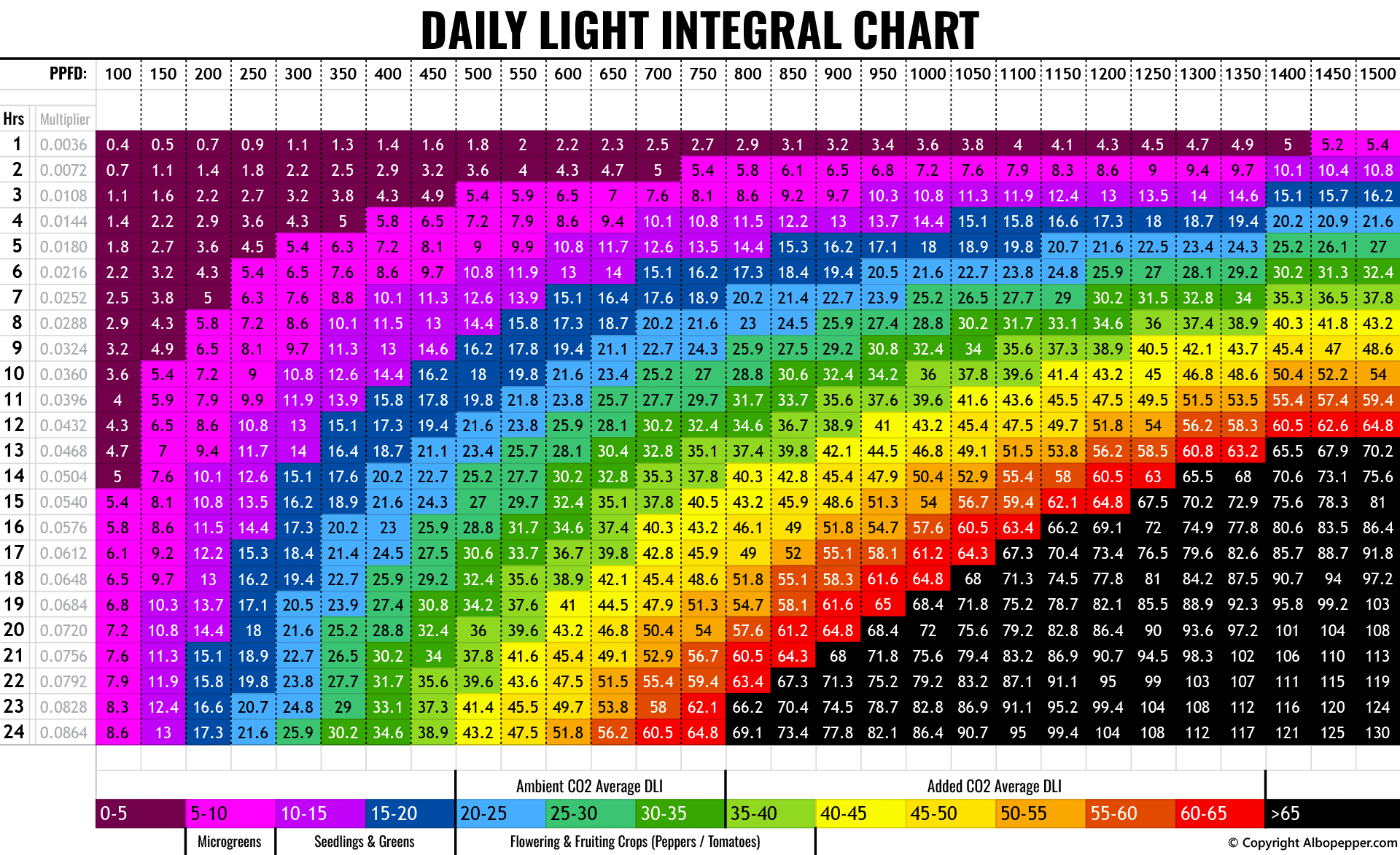
This daily light integral (DLI) chart shows the relationship between photoperiod and PPFD. (click to enlarge)

The daily light integral chart shown above is colored coded using the exact same values as the US DLI map. This allows you to quickly compare artificial grow light settings to the natural sunlight exposure that outdoor plants receive.
For example, in Pennsylvania, in April, the average DLI is between 30 and 35. By looking at this DLI chart, you can determine the light intensity that would be needed to match typical outdoor levels. By scanning the chart, you can see that a 14 hour light cycle would require PPFD levels between 600 to 700 μmols.
Daily Light Integral for Plants:
To maintain optimal plant growth, it's important to provide adequate light levels as measured by the DLI. What DLI levels do plants really need? Unfortunately, there's no simple answer to that question. Different plant types are adapted to different light intensities. Some low light plants like lettuce have much lower requirements. On the other hand, high light plants such as tomatoes have much higher requirements for peak production.
Purdue University has put out some great information, including their own daily light integral chart. This DLI chart is plant-specific. It lists many greenhouse crops, showing the minimum DLI levels that the plants would need to achieve an acceptable quality of growth.
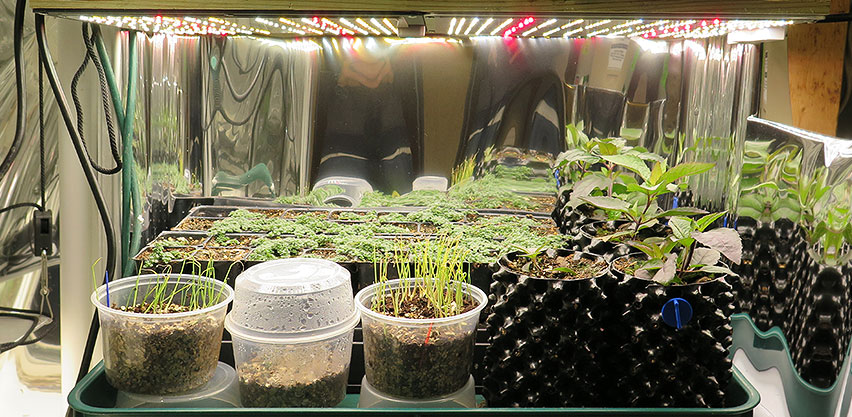
These dimmable LEDs are an excellent way dial in the perfect PPFD levels without needing to alter the hanging height.
ADJUSTING FOR DLI: If necessary, the light intensity can be boosted by placing your lights closer to the plants. Alternatively, increasing the duration of the light cycle is a second option. Both approaches effectively raise the DLI and boost plant growth!
Of course, when plants are getting too much light the reverse applies. Raising lights might solve the problem. This may increase your coverage area, allowing you to grow more plants. Or you can decrease the PPFD levels by dimming your light source. Reducing the light cycle is also advantageous due to the reduction in power consumption. Ideally, a grower will want their plants to yield more mass per watts consumed. That's why it's so important to understand how all of these metrics relate to each other.

